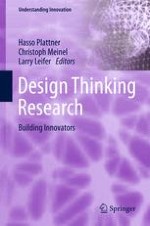2015 | OriginalPaper | Chapter
Embodied Design Improvisation: A Method to Make Tacit Design Knowledge Explicit and Usable
Authors : David Sirkin, Wendy Ju
Published in: Design Thinking Research
Publisher: Springer International Publishing
Activate our intelligent search to find suitable subject content or patents.
Select sections of text to find matching patents with Artificial Intelligence. powered by
Select sections of text to find additional relevant content using AI-assisted search. powered by
